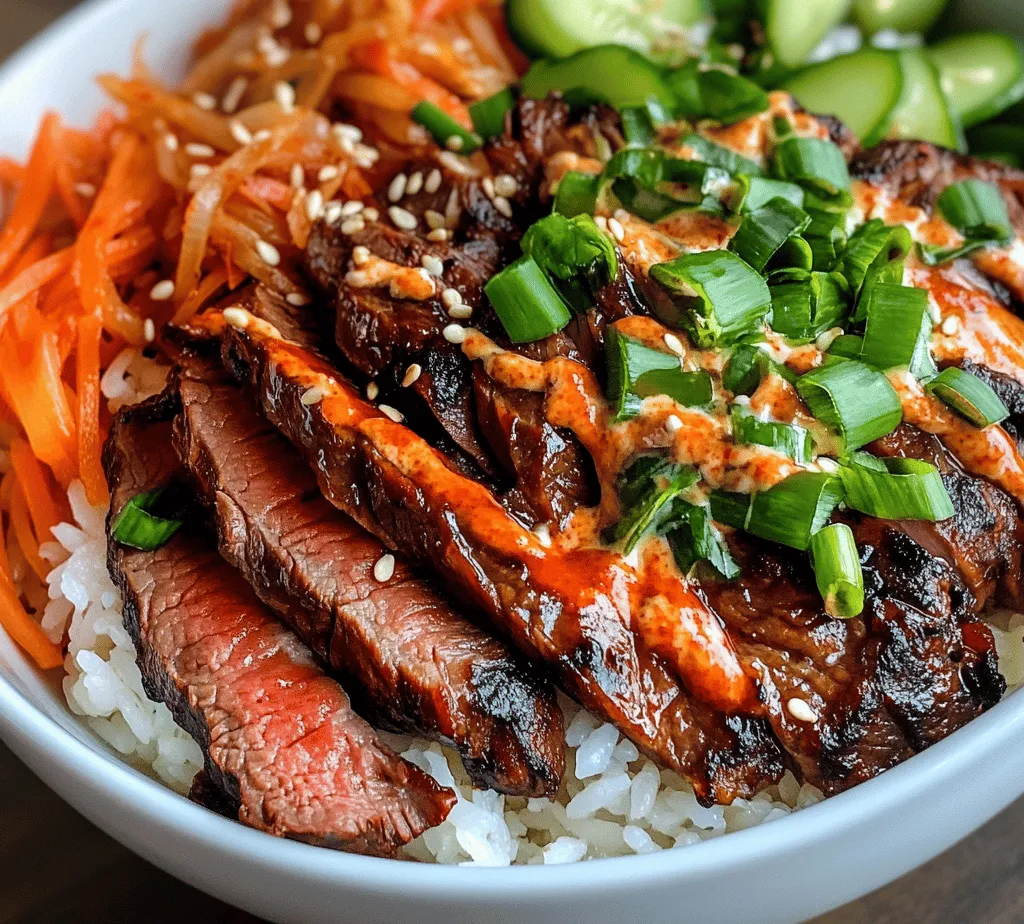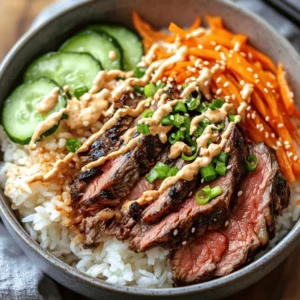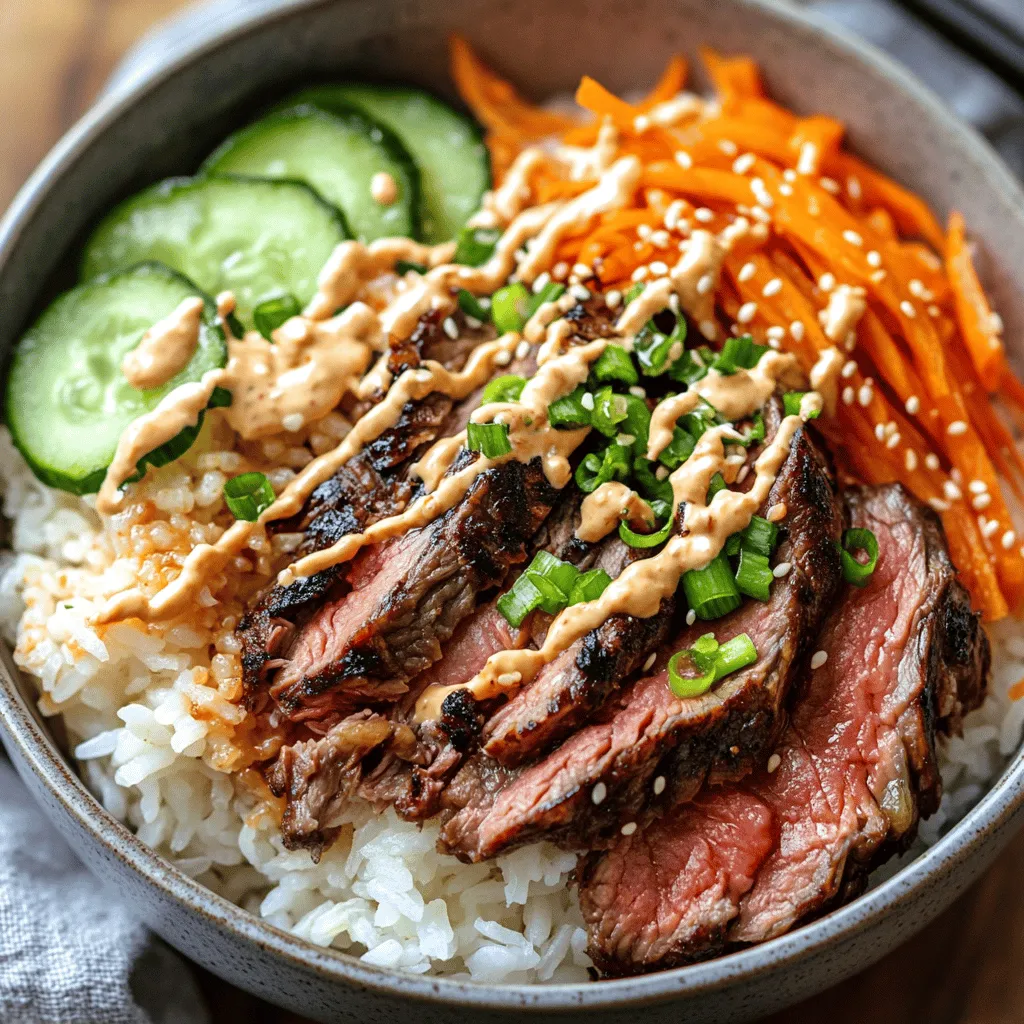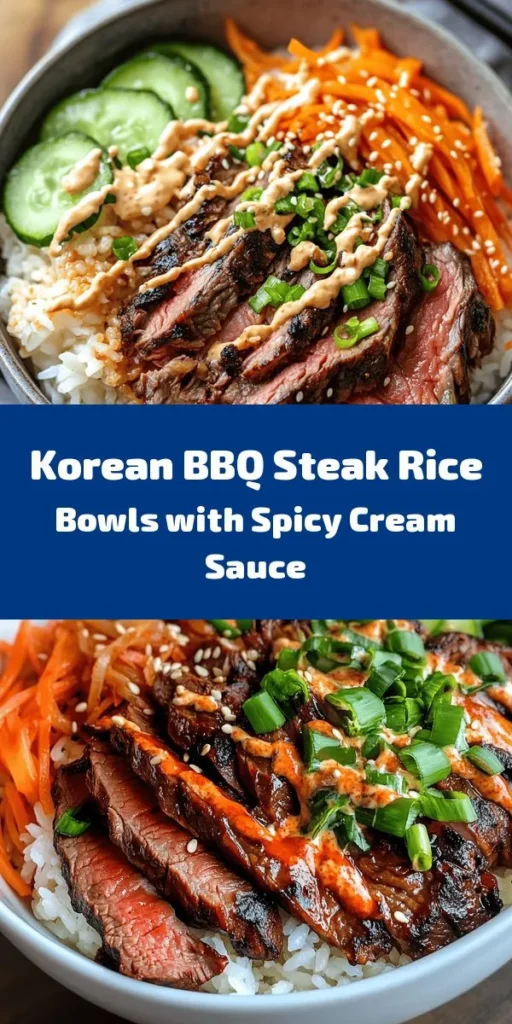Introduction
Korean BBQ has become a global sensation, captivating food enthusiasts with its unique blend of flavors, aromas, and cooking techniques. This culinary trend is not just about grilling meat but also the vibrant atmosphere it creates, where friends and family gather around tables, enjoying sizzling dishes and the joy of shared experiences. One dish that perfectly encapsulates this essence is the Sizzling Korean BBQ Steak Rice Bowls with Spicy Cream Sauce.
This dish combines the rich, savory flavors of marinated steak with the satisfying crunch of fresh vegetables and the comforting warmth of steamed rice, all topped with a creamy, spicy sauce that adds an exciting twist. The interplay of textures and flavors—from the tender, juicy meat to the crisp vegetables and the luscious sauce—makes this dish not only a feast for the palate but also a visual delight.
Whether you are a Korean cuisine aficionado or a newcomer eager to explore, this recipe promises to bring the heart of Korean BBQ right into your kitchen. Let’s dive into the essential components that make this dish so irresistible.
Understanding the Ingredients
Flank Steak or Ribeye: The Cut of Meat
When it comes to preparing Korean BBQ, the choice of meat plays a crucial role in achieving the desired flavor and tenderness. Flank steak and ribeye are two of the most popular cuts used in Korean BBQ. Flank steak is known for its rich flavor and lean texture, making it an excellent choice for marinating. Its fibrous structure absorbs marinades beautifully, resulting in a tender and juicy bite after cooking.
Ribeye, on the other hand, is marbled with fat, providing a succulent and flavorful experience. The fat renders during cooking, adding moisture and richness to the dish. Both cuts are worthy contenders for this recipe, and your choice may depend on personal preference or availability. Regardless of the cut, the key is to slice the steak against the grain to ensure tenderness in each bite.
Gochujang: The Essence of Korean Cuisine
No discussion of Korean BBQ would be complete without mentioning gochujang, a fermented red chili paste that serves as a cornerstone of Korean cuisine. Its complex flavor profile—spicy, sweet, and umami-rich—elevates dishes and adds depth to marinades. In this recipe, gochujang not only imparts heat but also contributes a subtle sweetness that balances the savory notes of the steak.
In addition to its flavor, gochujang offers health benefits thanks to its fermentation process, which is said to aid digestion and boost metabolism. When combined with other marinade ingredients, it creates a robust base that enhances the overall eating experience.
Overview of the Marinade Ingredients
The marinade for the steak is where the magic begins. Alongside gochujang, typical marinade ingredients include soy sauce, sesame oil, garlic, ginger, and sugar. Each ingredient serves a specific purpose:
– Soy Sauce: Provides a salty, umami depth while helping to tenderize the meat.
– Sesame Oil: Adds a nutty flavor, enhancing the overall richness of the dish.
– Garlic and Ginger: Bring aromatic notes, elevating the flavor profile with their distinctive warmth.
– Sugar: Balances the saltiness of the soy sauce and adds a touch of caramelization during cooking.
Together, these ingredients create a marinade that not only infuses the steak with flavor but also helps to tenderize it, ensuring that each bite is succulent and delicious.
Discussion on the Spicy Cream Sauce
The Spicy Cream Sauce is the crowning glory of this dish, providing a creamy texture that complements the robust flavors of the marinated steak. Made with ingredients such as mayonnaise, yogurt, or sour cream, combined with additional gochujang or sriracha, this sauce strikes a beautiful balance between heat and creaminess.
The creaminess of the sauce acts as a cooling agent against the heat from the gochujang, creating a harmonious blend that elevates the dish. You can easily adjust the spice level according to your preference—add more gochujang for an extra kick or reduce it for a milder flavor.
Marinating the Steak for Maximum Flavor
Marinating the steak is an essential step in this recipe that allows the flavors to penetrate deep into the meat, resulting in a delicious and tender outcome. The marination process not only infuses the steak with flavor but also breaks down the muscle fibers, making the meat more enjoyable to eat.
Step-by-Step Breakdown of the Marinade Preparation
1. Gather Ingredients: Start by assembling all the marinade ingredients: flank steak or ribeye, soy sauce, sesame oil, minced garlic, grated ginger, sugar, and gochujang.
2. Mix the Marinade: In a bowl, combine the soy sauce, sesame oil, minced garlic, grated ginger, sugar, and gochujang. Whisk together until the sugar is dissolved and all ingredients are well incorporated.
3. Prepare the Steak: If using flank steak, slice it into thin strips against the grain. This method not only ensures tenderness but also allows for better absorption of the marinade.
4. Marinate the Steak: Place the sliced steak in a zip-top bag or a shallow dish and pour the marinade over it. Ensure that all pieces are evenly coated. If using a bag, seal it tightly, removing excess air. If using a dish, cover it with plastic wrap.
Tips for Ensuring Even Coating and Marination Time
– Ensuring Even Coating: Massage the marinade into the steak through the bag or with your hands if using a dish. This helps the marinade adhere better and ensures that every piece is evenly coated.
– Marination Duration: For optimal flavor infusion, marinate the steak for at least 30 minutes. However, for the best results, aim for 2 to 4 hours. If you have the time, marinating overnight in the refrigerator will yield even more intense flavors.
– Avoid Over-Marinating: While marinating is crucial, avoid leaving the steak in the marinade for too long, as the acidity from the soy sauce can cause the meat to become mushy.
With the steak marinated to perfection, we are now well on our way to creating a delicious Sizzling Korean BBQ Steak Rice Bowl with Spicy Cream Sauce. In the next section, we will delve into the creation of the spicy cream sauce that will beautifully complement our marinated steak.

Techniques for Grilling Steak: Achieving the Right Temperature and Doneness
Grilling steak to perfection is both an art and a science. To achieve that coveted sear and juicy interior, it’s essential to understand the nuances of temperature and doneness. Start by letting your steak come to room temperature, which typically takes about 30 minutes. This ensures even cooking throughout.
For grilling, a high temperature is key. Preheat your grill to a high setting, ideally around 450°F to 500°F (230°C to 260°C). This high heat helps create a beautiful crust while sealing in the juices. To check for doneness, use a meat thermometer:
– Rare: 120°F to 125°F (49°C to 52°C)
– Medium rare: 130°F to 135°F (54°C to 57°C)
– Medium: 140°F to 145°F (60°C to 63°C)
– Medium well: 150°F to 155°F (65°C to 68°C)
– Well done: 160°F (71°C) and above
Remember, the steak will continue to cook slightly after being removed from the grill, a phenomenon known as carryover cooking. This is why it’s wise to take it off the grill when it’s about 5°F (3°C) below your target temperature.
Tips for Selecting the Right Cooking Equipment: Grill vs. Grill Pan
Choosing the right cooking equipment can make a significant difference in the outcome of your Sizzling Korean BBQ Steak Rice Bowls. While a traditional outdoor grill is perfect for achieving authentic char and flavor, a grill pan can also yield fantastic results, especially if you’re cooking indoors or during inclement weather.
Grill: An outdoor grill allows for higher heat and that signature smoky flavor that defines Korean BBQ. If using a gas or charcoal grill, ensure it’s well-maintained for consistent heat distribution.
Grill Pan: A cast-iron grill pan is a great alternative for indoor cooking. It retains heat exceptionally well and can create grill marks that are visually appealing. Preheat the pan to a high temperature before adding the steak to ensure proper searing.
Regardless of the choice, both methods can produce delicious steak; it ultimately depends on your preference and availability of equipment.
Importance of Resting the Steak Post-Cooking for Juiciness
After grilling, resist the temptation to slice into the steak immediately. Resting is a crucial step that allows the juices to redistribute throughout the meat, resulting in a more succulent bite. Transfer the grilled steak to a cutting board and loosely tent it with aluminum foil. Let it rest for about 5 to 10 minutes before slicing. This time allows the fibers to relax, making the steak more tender and juicy when served.
Assembling the Rice Bowls
Now that your steak is perfectly grilled and rested, it’s time to assemble your Sizzling Korean BBQ Steak Rice Bowls. The key to a visually appealing and delicious bowl is to build it layer by layer, ensuring a harmonious balance of flavors and textures.
1. Start with Rice: Begin with a generous portion of fluffy white rice or brown rice at the base of your bowl. The rice serves as a comforting foundation that absorbs the flavors of the dish.
2. Layer the Steak: Thinly slice the rested steak against the grain into bite-sized pieces. Arrange these slices artfully over the rice, allowing their juices to mingle with the grains.
3. Add Vegetables: Incorporate a variety of vegetables for color and crunch. Consider adding fresh cucumber slices, shredded carrots, and radishes. These add freshness and contrast to the hearty steak.
4. Incorporate Traditional Toppings: Kimchi is a must-have for an authentic Korean BBQ experience. Its tangy and spicy profile complements the rich flavors of the steak beautifully. You can also add pickled vegetables for an extra zing.
5. Optional Fried Egg: For a modern twist, top your bowl with a fried egg. The runny yolk adds creaminess and enriches the overall dish.
Tips on Portioning Ingredients for a Satisfying Meal
When assembling the rice bowls, balance is key. Aim for equal portions of rice, steak, and vegetables to create a satisfying meal. A good rule of thumb is to have about one cup of rice, six to eight ounces of steak, and a half-cup of assorted vegetables per bowl. This ensures that each bite is a delightful mix of flavors and textures.
The Role of Accompaniments
Korean BBQ is not just about the main dish; it’s also about the accompaniments, known as banchan. These small side dishes enhance the dining experience and provide a range of flavors that complement the steak bowls.
1. Rice: The foundation of any Korean meal, rice is essential for balancing rich and spicy flavors.
2. Vegetables: Including fresh or pickled vegetables adds a refreshing crunch. Popular options include pickled radish, seasoned spinach, and bean sprouts.
3. Spicy Sauce: The spicy cream sauce you prepared earlier is an integral part of the bowl, providing a creamy, spicy kick that enhances the overall flavor profile.
Each component plays a vital role, creating a multi-dimensional dining experience that is both satisfying and delicious.
Variations and Customizations
One of the joys of creating your own Korean BBQ Steak Rice Bowls is the ability to customize them to suit different dietary preferences and seasonal ingredients.
– Alternative Proteins: If you’re looking for alternatives, consider using chicken, pork, or tofu. Each protein can be marinated similarly to the steak and will absorb the delicious flavors.
– Seasonal Vegetables: Feel free to add seasonal vegetables to your bowl. Grilled zucchini, asparagus, or bell peppers can elevate the dish and add nutritional value.
– Adjusting Spice Levels: If you prefer a milder sauce, reduce the amount of gochujang or chili paste in the spicy cream sauce. Alternatively, for those who enjoy an extra kick, consider adding chopped fresh chili or a sprinkle of chili flakes for added heat.
Serving Suggestions and Presentation Tips
Presentation can elevate your Sizzling Korean BBQ Steak Rice Bowls from a simple meal to a culinary showcase. Here are some creative ways to present your bowls:
– Colorful Bowls: Use clear glass or brightly colored bowls to showcase the vibrant ingredients. Layering the components in distinct sections can create visual appeal.
– Garnishing: A sprinkle of sesame seeds and freshly chopped herbs like cilantro or green onions adds an inviting touch and enhances the dish’s aroma.
– Pairing Beverages: Serve your bowls with traditional Korean drinks like soju or makgeolli for a complete experience. Alternatively, light beers or refreshing iced teas can complement the flavors beautifully.
Conclusion
Sizzling Korean BBQ Steak Rice Bowls with Spicy Cream Sauce offer an enticing combination of flavors and textures that are sure to impress. The smoky, savory steak pairs perfectly with the creamy, spicy sauce and fresh vegetables, creating a delightful culinary experience at home. Whether you are hosting a dinner party or enjoying a quiet meal, this recipe brings the essence of Korean BBQ right to your table.
We encourage you to try this recipe and explore the versatility of Korean BBQ. From experimenting with different proteins and vegetables to customizing spice levels, the possibilities are endless. Embrace the joy of cooking and the communal spirit of sharing delicious meals with loved ones. Enjoy the satisfaction of creating a dish that is not only flavorful but also a feast for the eyes.



